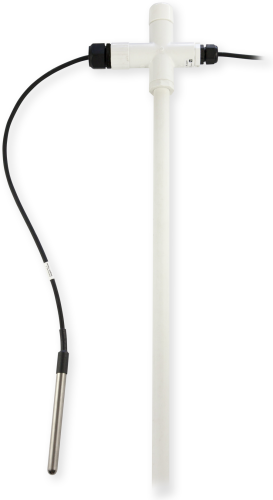
Rugged, digital temperature measurements






Visão Geral
The CS230 temperature profiler uses SDI-12 digital technology for simple integration. SDI-12 does away with analog measurement inaccuracies and susceptibility to electrical noise. The CS230 consists of a rigid probe assembly and up to four optional external temperature probes. The rigid probe assembly maintains the precise position of the temperature points within the profile, while protecting the temperature sensors in all mediums for the long-term.
The CS230 is suited for a wide variety of applications and environments. The completely sealed probe assembly and external probes permit the CS230 to be used in roadbeds, soils, and water (snow and ice). Applications where the CS230 is used include spring-load adjustment, frost and permafrost monitoring, and soil and water temperature profiling.
Leia mais
Benefícios e Características
- Lifetime min/max temperature recording
- Customizable measurement spacing for any number of applications
- Available external probes simplify installation for roadbed applications
- User-resettable min/max temperature recording
- Automatic 1 second temperature update
- Makes use of the included SGB3 to protect against electrical surges
- One SDI-12 channel is used to connect all temperature sensors
- Low power—suitable for remote applications
- No calibration required
- Serial number & installation depth data for each location stored onboard each sensor
- Excellent long-term stability of measurements
- Comprehensive measurement range
imagens

Produtos Relacionados
Descrição Técnica
When power is supplied to the CS230 probe, the internal electronics will continuously measure the temperature at an approximate rate of 1 measurement per second. Every output measurement obtained from the sensor is a running average of 10 consecutive 1-second readings. The accuracy specification is based on an average of 10 consecutive readings. For this purpose, after initial power-up, it is recommended to delay 10 seconds to obtain the best accuracy.
Because the sensor is obtaining a measurement every 1 second, it is recommended to use the Continuous measurement command to obtain the temperature readings. Using the “R” commands will reduce the time taken to obtain a reading with the SDI-12 protocol.
Compatibilidade
Please note: The following shows notable compatibility information. It is not a comprehensive list of all compatible products.
Data Loggers
| Product | Compatible | Note |
|---|---|---|
| CR1000 (retired) | ||
| CR300 (retired) | ||
| CR3000 (retired) | ||
| CR350 | ||
| CR6 | ||
| CR800 (retired) | ||
| CR850 (retired) |
Additional Compatibility Information
Configuration
Our handy CS230 Configuration Tool can help you configure your profiler, and it assists our staff with customizing your profiler to your specifications. It includes parameters for lead length, first sensor from ground, and distance between sensors.
Especificações
| Operating Temperature Range | -55° to +85°C |
| Typical Accuracy | ±0.2°C (-40° to +85°C) includes lifetime drift |
| Worst Case Accuracy |
|
| Resolution | 0.0078°C |
| Communications | SDI-12 |
| Maximum Sensors per Probe | 32 |
| Minimum Spacing | 5 cm (1.97 in.) |
| Optional External Probes | 4 (maximum) |
| Supply Voltage | 9 to 28 Vdc |
| Current Consumption |
|
| Warm-up Time on Power up | 10 s |
| Probe Diameter | 2.13 cm (0.84 in.) |
| Standard External Probe Length | 45 cm (18 in.) |
| Maximum Length | 3.0 m (118 in.) |
| Maximum Cable Length | 152 m (500 ft) |
| Electronics Sealing Classification | IP68 |
Documentos Relacionados
Lâminas do produto
Trabalhos técnicos
Conformidade
Downloads
CS230/CS231 Program Examples (4 KB) 26-08-2021
Three example programs that measure the temperature sensors on the CS230/CS231 probe. The number of temperature sensors and the SDI-12 control terminal are entered as constants at the beginning of the programs to allow users to easily change them to match their application. The example programs support the CR6 and CR1000X data loggers. Programs for other dataloggers will be similar.
The cs231.CRB program measures 15 sensors with SDI-12 addresses 1 through 9 and A through F. Every 60 s, the aR0! command polls each temperature sensor, then the data is stored in a table. Other common station data is measured every 60 seconds and stored to a daily data table.
The cs231-slow.CRB program measures 20 temperature sensors with SDI-12 addresses 1 through 9 and A through F. The program uses the SlowSequence instruction and the aR0! command to poll each temperature sensor every 60 seconds. The temperature sensor data is stored to a data table on the same interval. Other common station data is measured every 5 seconds and stored to daily and hourly data tables.
The cs231-metdata.CRB program measures 15 sensors with SDI-12 addresses 1 through 9 and A through F. Each temperature sensor is polled on power up and daily with the aR1! command to determine metadata, which is stored in a daily data table. Other common station data is measured every 60 seconds and stored to a separate daily data table.



